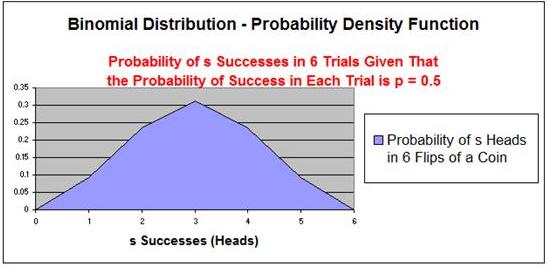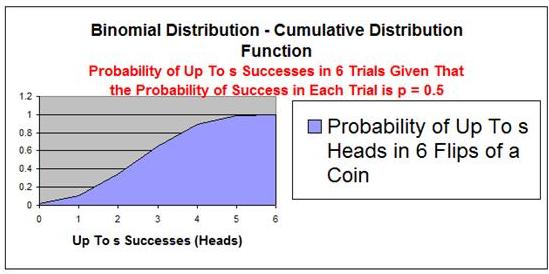|
The above expression is known as
the Binomial Coefficient and often referred to as "n chose k." This is
equal to the number of possible ways to choose k successes from n trials.
This is equivalent to the total number of possible combinations of n objects
taken k at a time simultaneously.
Back to Binomial Distribution Table of Contents
Example of Using the Binomial Probability Density
Function
Probability of success in each trial =
p = 0.5 --->
q = 1-
p = 1 - 0.5
= 0.5 Number of trials =
n = 6
Binomial Distribution Cumulative Distribution Function
Cumulative Distribution Function
= Pr (X ≤ k)
Example of Using the Binomial Cumulative
Distribution Function
For example, the Cumulative Distribution
Function would be used to calculate the probability of up to 4 heads in 6
flips of a coin.
Back to Binomial Distribution Table of Contents
|
| Normal (X, µ, σ2) = | ||||||
| n | p | np | np(1-p) | X | Binomial (X, n, p) | Normal (X, np, np(1-p) ) |
| 1000 | 0.4 | 400 | 240 | 385 | 0.0162 | 0.0161 |
| 400 | 0.0257 | 0.0258 | ||||
| 415 | 0.0160 | 0.0161 |
The Poisson Distribution can be estimated using the Binomial Distribution if
n is large and
p is small (less than 0.10). This approximation works well if
n≥100 and
np<10. The approximation is valid because the Binomial
Distribution converges to the Poisson Distribution and
n (the number of
trials) approaches infinity and np remains fixed.
For example, if
n = 100 and
p =
0.03, then np = 3. If
n ≥ 100 and
np
< 10, then
the Poisson and Binomial Probability Density Functions should be very close for
various values of the count variable X. This is demonstrated in the table
below:
| Poisson (X, λ) = | ||||||
| n | p | np | X | Binomial (X, n, p) | Poisson (X, np) | |
| 100 | 0.03 | 3 | 1 | 0.0162 | 0.0161 | |
| 2 | 0.0257 | 0.0258 | ||||
| 3 | 0.0160 | 0.0161 |
The Binomial Distribution is a specific case of the more general Multinomial Distribution
Back to Binomial Distribution Table of Contents
Problem 1: Probability of
Getting a Certain Range of Successes for a Binomial
Variable Trials
Problem: What is the probability of getting
between 3 and 5 heads on 10 flips of a fair coin (
p =
0.50) ?
Probability of Success in Each Trial =
p =
0.50
Number of Trials = n = 10
Maximum Number of Successes =
k =
5
Minimum Number of Successes =
k =
3
Probability of getting between 3 and 5 heads = Pr(X=3) +
Pr(X =4) + Pr(X =5)
PR (X = 3) = f(k;
n, p) =
n! / [
k! * (
n - k )! ] *
pk *
q(n-k)
PR (X = 3) = f(3; 10, 0.50) = 100! / [ 3! * ( 10 - 3 )! ] * (0.50)3 *
(0.50)(10-3)
PR (X = 3) = 0.1172 = 11.72%
PR (X = 4) = f(k;
n, p) =
n! / [
k! * (
n - k )! ] *
pk *
q(n-k)
PR (X = 4) = f(4; 10, 0.50) = 100! / [ 4! * ( 10 - 4 )! ] * (0.50)4 *
(0.50)(10-4)
PR (X = 4) = 0.2050 = 20.50%
PR (X = 5) = f(k;
n, p) =
n! / [
k! * (
n - k )! ] *
pk *
q(n-k)
PR (X = 5) = f(5; 10, 0.50) = 100! / [ 5! * ( 10 - 5 )! ] * (0.50)5 *
(0.50)(10-5)
PR (X = 5) = 0.2461 = 24.61%
Probability of getting between 3 and 5 heads =
Pr(X=3) +
Pr(X =4) +
Pr(X =5)
Probability of getting between 3 and 5 heads =
11.72% +
20.50% + 24.61%
Probability of getting between 3 and 5 heads = 56.83%
There is a 56.83% probability of getting between 3 and 5 heads on 10 flips of
a fair coin.
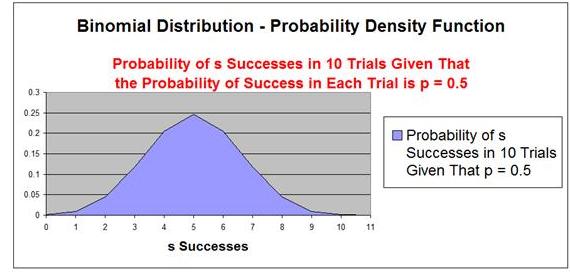
This same problem is solved in the Excel Statistical Master with only 1 Excel formula. That's it. The Excel Statistical Master teaches you everything in step-by-step frameworks. You'll never have to memorize any complicated statisical theory.
Back to Binomial Distribution Table of Contents
Problem 2
Problem 2: Probability of Getting a Certain Range of Successes for a Binomial Variable Trials
Problem: What is the probability of that between 2 and 4 products out of 100 require service if 2% of all products require service?
Probability of Success in Each Trial = p =
0.02
Number of Trials = n = 100
Maximum Number of Successes = k =
4
Minimum Number of Successes = k =
2
Pr (2 ≤ X ≤ 4 ) = Pr ( X ≥
2 ) AND Pr ( X ≤ 4 )
= Pr ( X ≤ 4 ) AND
Pr ( X ≥ 2 )
= PR (X ≤ 4) -
Pr ( X ≤ 2)
PR (X ≤ 4) =
PR (X = 4) + PR (X = 3)
+
PR (X = 2) + PR (X = 1) + PR (X = 0)
PR (X ≤2) =
PR (X = 2) + PR (X = 1) + PR (X = 0)
PR (X ≤ 4) -
PR (X ≤2) =
PR (X = 4) + PR (X = 3)
PR (X = 4) = f(k;
n, p) =
n! / [
k! * (
n - k )! ] *
pk *
q(n-k)
PR (X = 4) = f(4; 100, 0.02) = 100! / [ 4! * ( 100 - 4 )! ]
* (0.02)4 * (0.98)(100-4)
PR (X = 4) = 0.0902 = 9.02%
PR (X = 3) = f(k;
n, p) =
n! / [
k! * (
n - k )! ] *
pk *
q(n-k)
PR (X = 3) = f(3; 100, 0.02) = 100! / [ 3! * ( 100 - 3 )! ] * (0.02)3 *
(0.98)(100-3)
PR (X = 3) = 0.1823 = 18.23%
PR (X ≤ 4)
-
PR (X ≤2)
=
PR (X = 4) + PR (X = 3)
PR (X ≤ 4) - PR (X
≤2) = 9.02% + 18.23% = 27.25%
There is a 27.25% probability that between 2
and 4 products out of 100 will need service if the probability of a product
needing service is 2%.
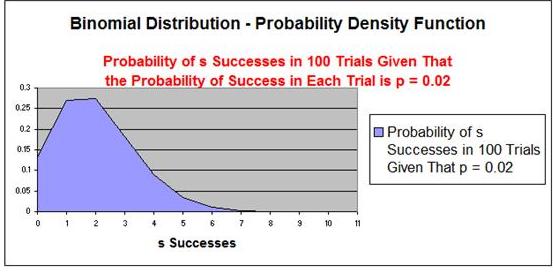
This same problem is solved in the Excel Statistical Master with only 1 Excel formula. The Excel Statistical Master is the fastest way for you to climb the business statistics learning curve.
Back to Binomial Distribution Table of Contents
Problem 3: Finding Mean, Variance, and Standard Deviation Given p (Probability of Success) and n Number of Binomial Trial Occurrences.
Problem: A gambling machine makes a payout every 15 plays on average. The machine is played 40 times per hour on average. What is the mean number of payouts per hour and the variance and standard deviation in the number of hourly payouts? Assume that the occurrences of payout are binomially distributed
.
Probability of Success (Payout) in Each Trial = p =
1/15 = .06667
Probability of No Success (No Payout) in Each Trial = q = 1 - p = .93333
Number of Trials = n = 40
This problem uses Binomial formulas (Sample Occurrence Formulas) because what is being measured is the mean number of occurrences from a large number of individual samples that each have only two possible outcomes.
Expected Sample Occurrence Parameters
Expected Sample Occurrence Mean =
np = 40 * 0.06667 =
2.6667
This is E(X) = the expected value of X (the count of successes in n trials)
Expected Sample Occurrence Variance
= npq = 2.6667 * 0.93333
= 2.4889
Expected Sample Occurrence Standard
Deviation = SQRT (npq)
= SQRT(2.4889)
= 1.5776
The expected number (Mean) of payouts every hour is 2.6667 with a Variance of 2.4889 and a Standard Deviation of 1.5776.
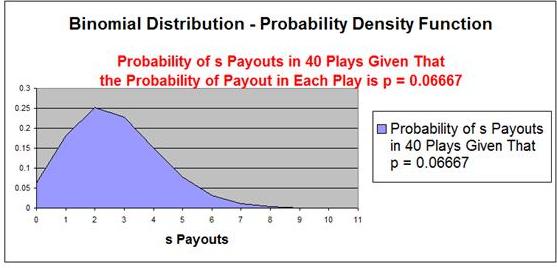
Back to Binomial Distribution Table of Contents
Problem 4: Finding the Mean, Variance, and Standard Deviation of a Sampled Proportion (p) Given 1 Large Sample Containing n Subjects.
Problem: In a large sales force, the ratio of salespeople having college degrees to those not having degrees is 5 to 2. Determine the mean, variance, and standard deviation of the sampling distribution of the proportion of salespeople not having degrees in a random sample of 30 salespeople.
.
The problem uses proportion formulas because what is being measured is a proportion of a single large sample.
Proportion of salespeople
not having degrees = p = 2/7 = 0.2857
Proportion of salespeople having degrees - q = 1 - p = 5/7 = 0.7143
Size of Sample = n = 30
Expected Sample Proportion Parameters
Expected Sample Proportion =
p = 0.2857
Expected Sample Proportion Variance
= pq = (0.2857) * (0.7143)
= 0.2041
Expected Sample Proportion Standard
Deviation = SQRT (pq/n)
=SQRT(0.2041 / 30)
= 0.0825
The expected Sample Proportion (Mean) of the proportion of degreed salespeople 0.2857 (28.57%) with a Variance of 0.2041 (20.41%) and a Standard Deviation of 0.0825 (8.25%).
Back to Binomial Distribution Table of Contents
Problem 5: Finding the probability of a certain number of sales for a specific number of customers given that probability of each customer purchasing, p (Probability of a sale), and n (Number of customers) is known.
Problem: A store has been tracking how many of their walk-in customers make a purchase. data collection over a long period of time revealed that 70% of walk-in customers made purchases while they remained in the store. What is the probability of exactly 10 out of the next 15 walk-in customers would make a purchase?
.
Probability of Success (Purchase) for Each
Customer = p =
70% = .7
Probability of No Success (No Payout) in Each Trial = q = 1 - p = .3
Number of Trials (Walk-in Customers) = n = 15
Exact Number of Successes = k = 10
This problem uses Binomial formulas (Sample Occurrence Formulas) because what is being measured is the mean number of occurrences from a large number of individual samples that each have only two possible outcomes.
Probability of making 10 sales = Pr(X=10)
PR (X = 10) = f(k;
n, p) =
n! / [
k! * (
n - k )! ] *
pk *
q(n-k)
PR (X = 10) = f(10; 15, 0.7) = 15! / [ 10! * ( 15 - 10 )! ] * (0.7)10 *
(0.3)(15-10)
PR (X = 10) = 0.206 = 20.6%
There is a 20.6% probability that 10 out of the
next 15 walk-in customers will make a purchase if the probability of each
walk-in customer making a purchase is 70%.
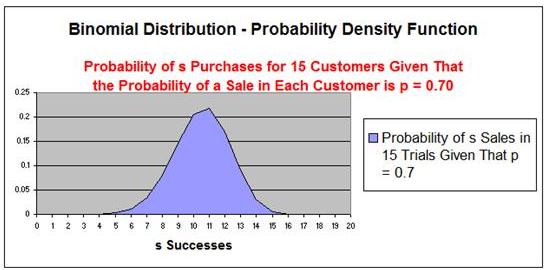
Back to Binomial Distribution Table of Contents
Problem 6: Finding the probability of a stock trader being above average if the number of successful trades he has made is known and the probability of an above-average stock trader making a successful sale is known.
Problem: An above-average stock trader makes a profit in 1 out of 4 transactions. An average stock trader makes a profit on average 1 out of 7 transactions. A below-average stock trader makes a profit on 1 out of 10 transactions on average. If a stock trader conducts 15 transactions and makes a profit on 2 of them, what is the probability of the stock trader being above average?
.
Probability of Success (Profit) for Each Transaction = p =
1/4 = 0.25
Probability of No Success (No Profit) in Each Transaction = q = 1 - p =
0.75
Number of Trials (Transactions) = n = 10
Maximum Number of Successes = k = 2
This problem uses Binomial formulas (Sample Occurrence Formulas) because what is being measured is the mean number of occurrences from a large number of individual samples that each have only two possible outcomes.
Probability of making up to 2 Profitable Transactions = Pr(X=1) +
Pr(X=2)
PR (X = 1) = f(k;
n, p) =
n! / [
k! * (
n - k )! ] *
pk *
q(n-k)
PR (X = 1) = f(1; 10, 0.25) = 1! / [ 10! * ( 10 - 1 )! ] * (0.25)\1 *
(0.75)(10-1)
PR (X = 1) = 0.188 = 18.8%
PR (X = 2) = f(k;
n, p) =
n! / [
k! * (
n - k )! ] *
pk *
q(n-k)
PR (X = 2) = f(2; 10, 0.25) = 2! / [ 10! * ( 10 - 2 )! ] * (0.25)2 *
(0.75)(10-2)
PR (X = 2) = 0.281 = 28.1%
Pr(X=1) + Pr(X=2) = 18.8% + 28.1% = 46.9%
There is a 46.9% probability that the stock
trader is above average if he completes up to 2 successful transactions in
his next 10 attempts if the above average stock trader normally completes 1
out of 4 transactions profitably.
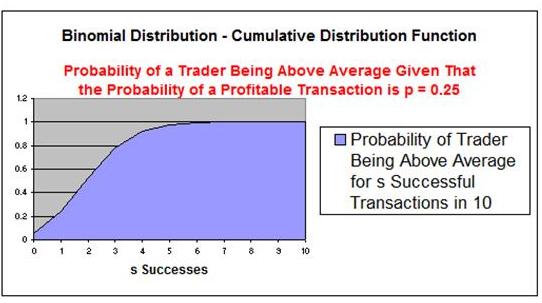
Back to Binomial Distribution Table of Contents
Problem 7: Finding the probability of a certain type of package passing down a conveyor belt if the probability of that type of package passing by is known.
Problem: A conveyor belt brings packages to a truck to loaded. The packages are either black or white. The probablity that a package is black is 40%. What is the probability that out of the next 10 packages, at least 2 are black and 2 are white?
The only possibility of at least two packages being white and 2 black would occur if the number of black packages equaled 0, 1, 9, or 10. The probability of at least 2 packages being black and 2 white would therefore equal 1 minus the probability that the number of black packages equals 0, 1, 9, or 10.
Probability of Success (Black Package) = p =
0.40
Probability of No Success (White Package) = q = 1 - p = 0.60
Number of Trials (Transactions) = n = 10
Exact Number of Successes = k = 0, 1, 9, 10
This problem uses Binomial formulas (Sample Occurrence Formulas) because what is being measured is the mean number of occurrences from a large number of individual samples that each have only two possible outcomes.
Probability of at least 2 Black and 2 White Packages in 10 =
1 - [ Pr(X=0) + Pr(X=1) + Pr(9) + Pr(10) ]
PR (X = 0) = f(k;
n, p) =
n! / [
k! * (
n - k )! ] *
pk *
q(n-k)
PR (X = 0) = f(0; 10, 0.40) = 0! / [ 10! * ( 10 - 0 )! ] * (0.40)\0 *
(0.60)(10-0)
PR (X = 0) = 0.0060 = 0.60%
PR (X = 1) = f(k;
n, p) =
n! / [
k! * (
n - k )! ] *
pk *
q(n-k)
PR (X = 1) = f(1; 10, 0.40) = 1! / [ 10! * ( 10 - 1 )! ] * (0.40)\1 *
(0.60)(10-1)
PR (X = 1) = 0.040 = 4.0%
PR (X = 9) = f(k;
n, p) =
n! / [
k! * (
n - k )! ] *
pk *
q(n-k)
PR (X = 9) = f(9; 10, 0.40) = 9! / [ 10! * ( 10 - 9 )! ] * (0.40)\9 *
(0.60)(10-9)
PR (X = 9) = 0.002 = 0.2%
PR (X = 10) = f(k;
n, p) =
n! / [
k! * (
n - k )! ] *
pk *
q(n-k)
PR (X = 10) = f(10; 10, 0.40) = 10! / [ 10! * ( 10 - 10 )! ] * (0.40)10 *
(0.60)(10-10)
PR (X = 10) = 0.0 = 0.0%
1 - [ Pr(X=0) + Pr(X=1) + Pr(9) +
Pr(10) ] = 1 - [ 0.006 + 0.040 + 0.002 +
0.0 ]
= 1 - 0.048 = 0.952 = 95.2%
There is a 95.2% probability at at
least 2 packages will be black and 2 packages will be white out of the next
10 packages if the probability of a package being black is 40%.
Back to Binomial Distribution Table of Contents
Problem 8: Finding the probability of getting a 4 at least twice in 5 tosses of a pair of fair dice.
Problem: Find the probability of getting a 4 at least twice in 5 tosses of a pair of fair dice. A fair die has a probability of 1/6 of landing on any of the 6 possible sides.
.A pair of dice can have 36 possible combinations (62). Four of those combinations can add up to 4 [ (1,3) (2,2) (3,1) (2,2) ]. The probability of getting a 4 in one roll of a pair of dice is 4/36 = .111 = 11.1%
Probability of Success (Getting a 4) in any
Roll = p =
11.1 = .111
Probability of No Success (Not getting a 4) in any Roll = q = 1 - p =
.889
Number of Trials (Rolls of a pair of dice) = n = 5
Exact Number of Successes = k = 2
This problem uses Binomial formulas (Sample Occurrence Formulas) because what is being measured is the mean number of occurrences from a large number of individual samples that each have only two possible outcomes.
Probability of getting two 4's = Pr(X=2)
PR (X = 2) = f(k;
n, p) =
n! / [
k! * (
n - k )! ] *
pk *
q(n-k)
PR (X = 2) = f(2; 5, 0.111) = 5! / [ 2! * ( 5 - 2 )! ] * (0.111)2 *
(0.889)(5-2)
PR (X = 2) = 0.867 = 86.7%
There is a 86.7% probability of
getting a 4 at least twice in 5 tosses of a pair of fair dice.
Back to Binomial Distribution Table of Contents
Statistics in Excel Home Normal Distribution
t Distribution Binomial Distribution
Regression Confidence Intervals Combinations and Permutations
Correlation and Covariance ANOVA Other Useful Distributions
Statistical Training Videos
Statistics Blog
Statistics Jobs
Latest Manuals in the Excel Master Series
Contact Information Statistics Jobs
Internet Marketing Book Review
Blog EntriesUsing Logistic Regression in Excel To Predict If a Prospect Will Buy
Taguchi Testing - What Is It and Is It a Good For Landing Page Optimization?
How To Use the Chi-Square Independence Test in Excel to Figure Out What Makes Your Customers Buy More
How To Solve ALL Hypothesis Tests in Only 4 Steps
Statistical Mistakes You Don't Want To Make
A Quick Normality Test Easily Done in Excel
The 7 Most Common Correctable Causes of Sample Data Appearing Non-Normal
How To Use the t Test in Excel To Find Out If Your New Marketing Is Working
Using the Excel t Test To Find Out What Your Best Sales Days Are
Nonparametric Tests - Completed Examples in Excel
Nonparametric Tests - How To Do the 4 Most Important in Excel
Nonparametric Tests - When the Marketer Should Use Them
Using All 3 Types of ANOVA in Excel to Improve Your PPC Marketing
Comparing Doing ANOVA in Excel with Doing It By Hand
How To Use the Chi-Square Variance Test to Find Out If Your Customers Are Becoming More or Less Focused In Their Spending
Using ANOVA in Excel to Increase Click-Through Rate
The Two Crucial Steps to Excel Regression That Most People Skip
How To Quickly Read the Output of Excel Regression
Work-Arounds for Excel 2003 and Excel 2007s Biggest Statistical Omissions
How To Build a Better Split-Tester in Excel Than the Google Website Optimizer
How To Use Dummy Variable Regression in Excel to Perform Conjoint Analysis
The Chi-Square Goodness-of-Fit Test - Excel's Easiest Normality Test
The Mann-Whitney U Test Done in Excel
The Kruskal-Wallis Test Done in Excel
The Spearman Correlation Coefficient Test Done in Excel
The Sign Test (Nonparametric) Done in Excel
The Wilcoxon Rank Sum Test Done in Excel
The Wilcoxon Signed-Rank Test for Small Samples Done in Excel
The Wilcoxon Signed-Rank Test for Large Samples Done in Excel
Excel's Most Basic Forecasting Tool - The Simple Moving Average
The Weighted Moving Average - A Basic and Accurate Excel Forecasting Tool
Excel Forecasting Tool #3 - Exponential Smoothing
Normal Distribution's 4 Most Important Excel Functions
Using the Normal Distribution To Find Your Sales Limits
Using the Hypothesis Test in Excel To Find Out If Your Advertising Worked
Using the Hypothesis Test in Excel To Find Out If Your Delivery Time Worsened
Using the Hypothesis Test in Excel To Test Your Headlines
Creating a Confidence Interval in Excel To find Your Customer Preferences
Creating a Confidence Interval in Excel To Find Your Real Daily Sales
Using the Normal Distribution To Find Your Range of Daily Sales
SPC Control Charts in Excel - Done Properly
Excel Model Building - Experts vs. Non-experts
Using the Excel Solver To Optimize Your Internet Marketing Budget
Is SPC Limited By The Central Limit Theorem?
Top 10 SEO Excel Functions - You'll Like These!
How To Use the Excel Solver to Find Your Sales Curve
How To Use If-Then-Else In Excel To Remove Matches From 2 Lists
How To Use VLOOKUP In Excel To Find Matches From 2 Lists In 2 Steps
Pivot Tables - How To Set Up Pivot Tables Correctly Every Time
Pivot Tables - One Easy Step That Will Double the Effectiveness of All of Your Pivot Tables!
VLOOKUP - Just Like Looking Up a Number In The Telephone Book
VLOOKUP - Looking Up a Quantity Discount in a Distant Excel Spreadsheet With VLOOKUP
Statistical Training Videos
How To Use Logistic Regression in Excel To Predict If Your Prospect Will Buy
How To Use the Chi-Square Independence Test in Excel to Find Out What Makes Your Customer Make Bigger Orders
How to Graph the Normal Distribution's Probability Density Function in Excel
How To Use Dummy Variable Regression in Excel to Perform Conjoint Analysis
How To Use All 3 Built-In Types of ANOVA in Excel to Improve PPC Marketing
How To Use the Chi-Square Variance Test in Excel to Find Out If Your Customers Are More Focused In Their Spending
How To Create a Histogram and Pareto Chart in Excel
How To Improve a Twitter Follower Acquisition Program with a Histogram in Excel
How To Use SocialOomph - The Most Versatile and Popular Tweet Automation Tool
How To Graph the Normal Distribution's Cumulative Distribution Function in Excel
How to Build a Better Split-Tester in Excel Than the Google Website Optimizer
How To Do the 4 Steps to Regression in Excel - Including the 2 Crucial Steps That Are Almost Always Ignored
Excel Regression Output - How to Quickly Read and Understand It
How To Use ANOVA in Excel to Increase Click-Through Rate in a Pay-Per-Click Campaign
How To Do ANOVA in Excel and also by Hand - Single-Factor ANOVA
Work-Arounds for Excel 2003 and Excel 2007's Biggest Statistical Omissions
How To Graph the Students t Distributions' Probability Density Function in Excel
How To Graph the Chi-Square Distribution's Probability Density Function in Excel
How To Graph the Weibull Distribution's PDF and CDF - in Excel
How To Add Followers To Your Twitter Account Faster Than You Thought Possible
How To Solve Problems with the Weibull Distribution in Excel
How To Solve Problems with the Gamma Distribution in Excel
Copyright 2013



